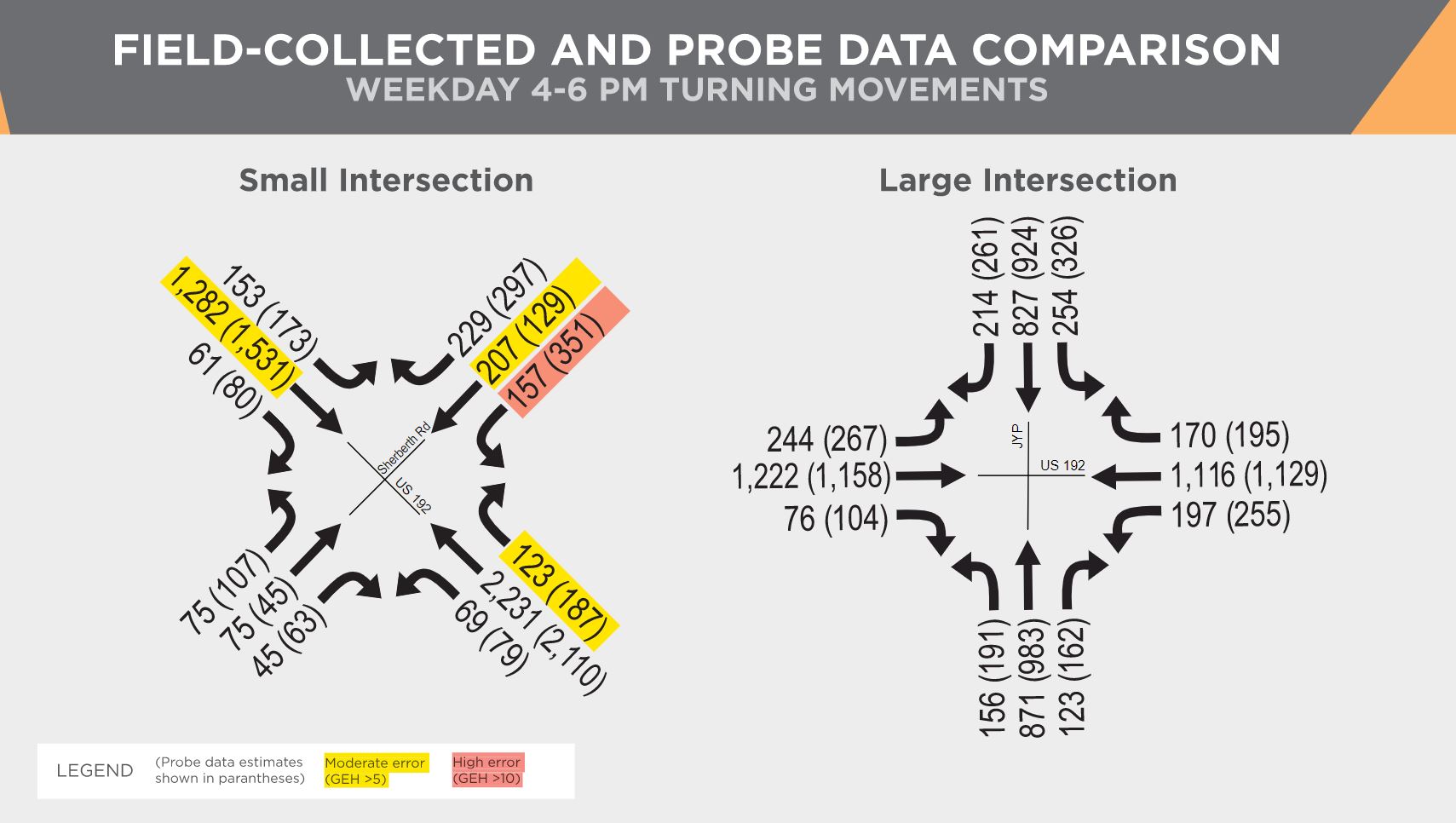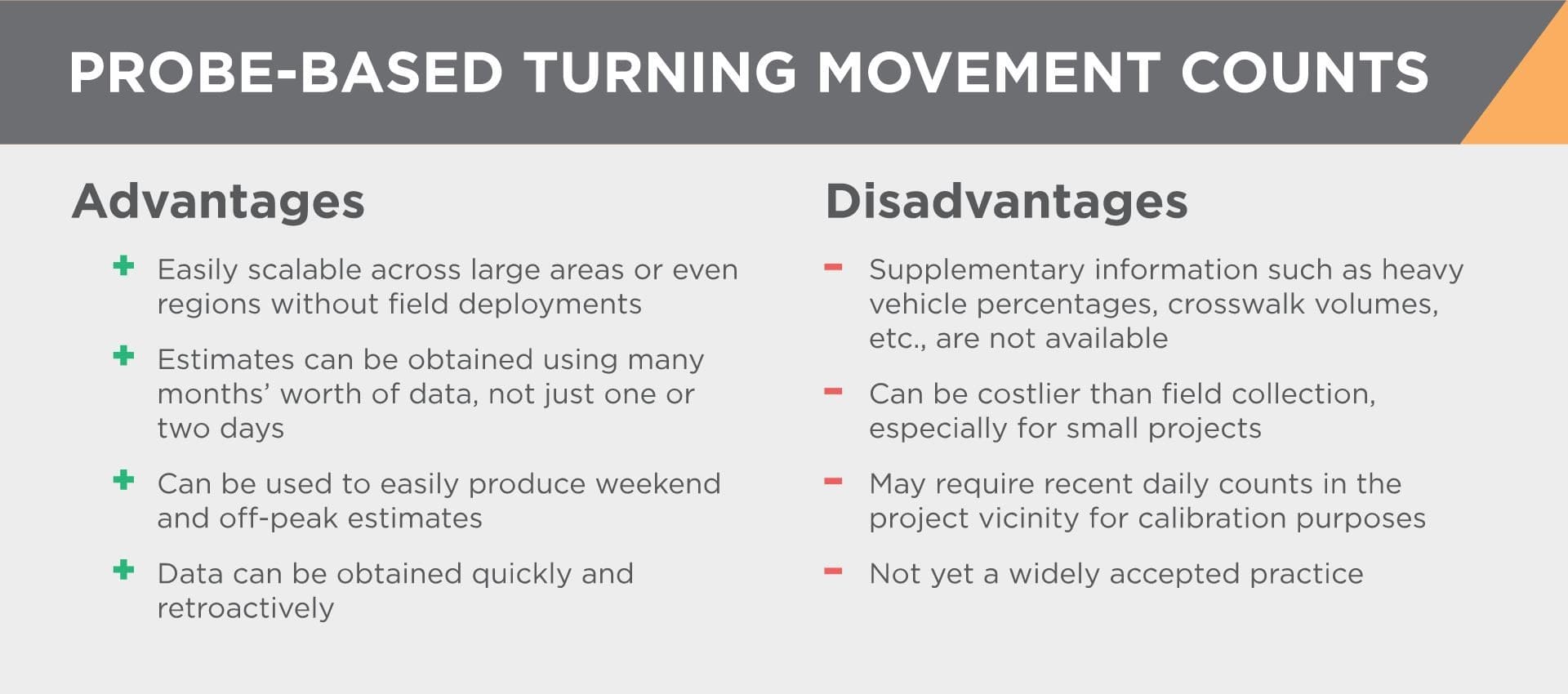November 18, 2019
Understanding traffic volumes is the bread and butter of a transportation engineer’s work. Volumes are usually measured along roadway segments or at intersections – where they are usually known as turning movement counts.
Traditionally, this work is done manually, which means a person counts vehicles, either on site or from video footage. A recent white paper from our own Jorge Barrios and Ryan Casburn explores another option: estimating turning movement counts using probe data.
In the past five years, probe data vendors like INRIX, HERE, AirSage, and StreetLight Data have begun offering traffic volume estimates based on their data samples. The data is collected from connected vehicles, cell phones, fleet GPS units, and other mobile sources.
“We wanted to see if some of the newer Big Data services could give us an idea of turning movement counts,” said Jorge, whose team obtained manual counts for two study intersections, one large, one small, to compare with the probe data. “We were surprised how well they lined up.”
"We wanted to see if some of the newer Big Data services could give us an idea of turning movement counts. We were surprised how well they lined up."
- Jorge Barrios, Senior Engineer
The key takeaway? Though less accurate than manual counts, probe data may be a decent substitute at a regional or planning level, where rough numbers are often good enough. It can also serve as an excellent tool to help agencies zero in on areas where they may want more detailed studies.
Big Data sources offer 24/7/365 access to information about how people use an intersection. That means analysts are no longer constrained to one or two peak hours in the morning or afternoon. Timeline is no longer a constraint either – probe data from past years is readily available.
“Kittelson is an innovative company always looking for ways to get better at what we do,” Jorge said. “Partnering with a probe data vendor, we can go on our computers, set up the analysis and synthesize the data for our clients.”
Comparing Field-Collected and Probe Data in Central Florida
Jorge and Ryan saw an opportunity to conduct this comparison study while working on a project for the Florida Department of Transportation. The test intersections are along US 192 in Central Florida. They compared the findings of a traditional traffic data collection and analysis effort at these two intersections with those from a probe data analysis using StreetLight Data. Here’s what they found.
#1: Probe data estimates were a reasonable substitute for field-collected traffic counts at the large intersection. At the large intersection, probe data estimates matched the field collected volumes closely. Turning movement counts are often used on projects to calculate the estimated delay with the Highway Capacity Manual (HCM). HCM delays calculated with the probe data were within 8% of the field-collected analysis in the morning and 14% in the afternoon. These error rates may seem high, but the fact that the probe data is a three-month average and the traffic counts cover a single day may account for some of the discrepancy.
#2: On low-volume intersection approaches, probe data estimates may be prone to high errors. Major differences in the count estimates for one of the approaches to the small intersection resulted in extremely large differences in overall results at that smaller study location. As the sample size of probe data continues to grow, their accuracy at smaller intersections may improve.

Comparison of weekday 4-6 PM turning movements. Legend: Field-collected turning movement counts (probe-based estimates)Moderate error (GEH > 5) | High error (GEH > 10)
In summary, we see potential for probe data to replace or augment manual counts in understanding big-picture patterns on major intersections over large areas. Other data collection methods such as Bluetooth may be more reliable than probe data on low-volume intersections, as they generally have higher sample sizes.
For probe data to become a more reliable source, more locations should be studied and “sanity checks” developed to identify major discrepancies without a field-collected comparison dataset. StreetLight Data is planning to offer turning movement count estimates in the near future. This will reduce the level of effort needed to obtain them and likely expand their use among transportation planners and engineers.

To find out more about using probe data to estimate your traffic volumes, download the white paper “Estimating Turning Movement Counts from Probe Data” below and contact Jorge Barrios or Ryan Casburn at Kittelson.
